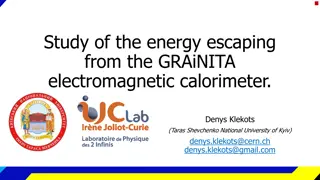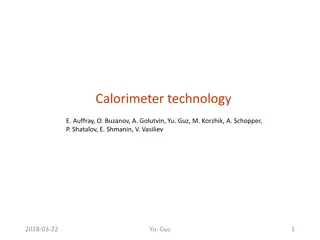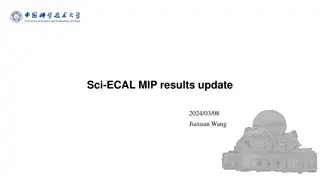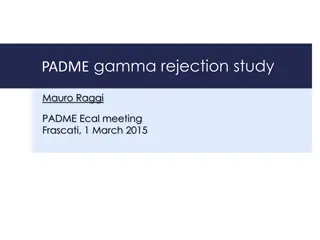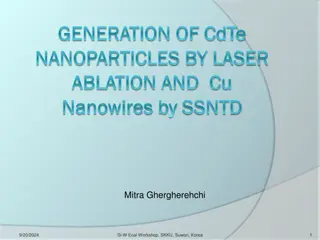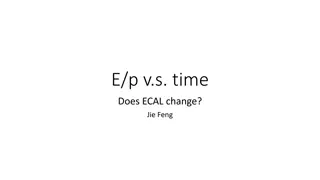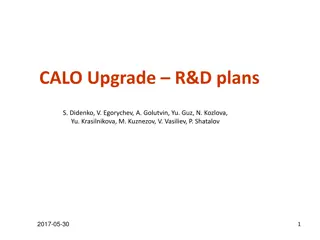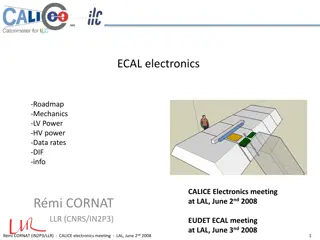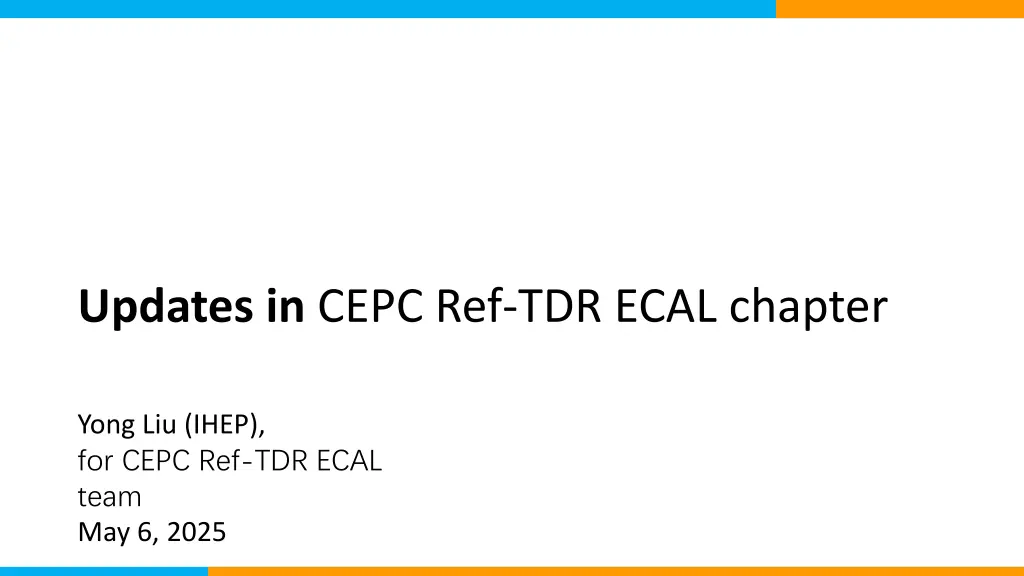
Updates in CEPC Ref-TDR ECAL Chapter: Key Technologies and Future Plans
Explore the re-organised structure and key technologies in Chapter 7 of the CEPC Ref-TDR ECAL, focusing on performance benchmarks, detector specifications, design challenges, and R&D. Dive into single photon reconstruction advancements and alternative solutions for enhanced performance post-2025. Stay informed about the latest studies and updated planning for ECAL, including simulation, neutral pions, Higgs to two photons, and more.
Download Presentation

Please find below an Image/Link to download the presentation.
The content on the website is provided AS IS for your information and personal use only. It may not be sold, licensed, or shared on other websites without obtaining consent from the author. If you encounter any issues during the download, it is possible that the publisher has removed the file from their server.
You are allowed to download the files provided on this website for personal or commercial use, subject to the condition that they are used lawfully. All files are the property of their respective owners.
The content on the website is provided AS IS for your information and personal use only. It may not be sold, licensed, or shared on other websites without obtaining consent from the author.
E N D
Presentation Transcript
Updates in CEPC Ref-TDR ECAL chapter Yong Liu (IHEP), for CEPC Ref-TDR ECAL team May 6, 2025
Chapter 7: re-organised structure in Ref-TDR 7.1 ECAL overview Key performance benchmarks and detector specifications 7.2 ECAL design 7.2.1 Detailed design (+mechanics, cooling) 7.2.2 Challenges and critical R&D 7.3 Key Technologies to address challenges Pattern recognition in orthogonal crystal bars EM performance 7.4 R&D and prototypes ECAL detector units: crystal, SiPM, Timing Prototype and beamtests (EM performance) Beam-induced backgrounds Calibration and monitoring 7.5 Simulation and Performance Neutral pions Higgs to two photons 7.6 Alternative Solutions SiW-ECAL ScW-ECAL IDEA dual-readout calorimeter (Only keep key information) 7.7 Summary and Future Plan 7.8 Cost table and justifications 2025/5/6 2 CEPC Detector Ref-TDR Review
Chapter 7: re-organised structure in Ref-TDR 2025/5/6 3 CEPC Detector Ref-TDR Review
Updated studies for Ref-TDR ECAL Key performance: single photon reconstruction with CyberPFA With core recognition: emphasizes more on the separation of near-by particles Updates: significantly enhances rec. of low-energy photons (below 300 MeV) Figure 1 shows the single-photon efficiency in CyberPFA (green solid line), decomposed into core recognition efficiency (blue dashed line) and "empty axis" efficiency (orange dashed line). The latter significantly enhances efficiency in the low-energy region. The discrepancy between the "empty axis" and PFO (Particle Flow Object) arises from the requirement of axis matching in two orthogonal directions. 2025/5/6 4 CEPC Detector Ref-TDR Review
Updated Planning after 2025 IDRC review for CEPC Ref-TDR ECAL chapter Yong Liu (IHEP) April 28, 2025
Chapter 7: re-organised structure in Ref-TDR 7.5 Simulation and Performance Neutral pions Higgs to two photons 7.6 Alternative Solutions SiW-ECAL and synergy with HGCAL silicon modules ScW-ECAL (Only keep key information) 7.7 Summary and Future Plan 7.1 ECAL overview Key performance benchmarks and detector specifications 7.2 ECAL design 7.2.1 Detailed design 7.2.2 Challenges and critical R&D 7.3 Key Technologies to address challenges Pattern recognition in orthogonal crystal bars EM performance 7.4 R&D and prototypes ECAL detector units: crystal, SiPM, Timing Prototype and beamtests (including EM performance with electron data) 7.8 Cost table and justifications 2025/5/6 6 CEPC Detector Ref-TDR Review
Latest status and updated Planning ECAL readout boards and cooling: an engineering design ECAL electronics and mechanics engineers will work together in next weeks on the engineering design, including readout boards and a cooling system ECAL reconstruction performance: Ongoing studies and crosschecks on two algorithms for reconstruction of low-energy photons better and clearer descriptions in Ref-TDR ECAL calibration schemes: more detailed studies Discussions on calibrations of crystals due to radiation doses and SiPMs due to non- linearity effects quantitative results in coming weeks Beam-induced backgrounds at ECAL Ongoing studies on suppression of BIB hit rates at ECAL: (1) balance of trigger threshold and EM performance; (2) potentials by using ECAL timing information 2025/5/6 7 CEPC Detector Ref-TDR Review
2025 IDRC review report (preliminary version) on the CEPC Ref-TDR ECAL chapter
Chapter 7: IDRC recommendations Preliminary IDRC Review Report Pursue the development of a prototype with final geometry (and existing readout ASICs), and struggle to confirm performance in an electron beam with a low momentum spread. Further develop calibration strategies to ascertain that necessary stability in transparency, linearity and uniformity can be achieved in situ without the need of a dedicated monitoring system. Further develop a preliminary engineering (design) of the gaps between modules and understand its impact in the reconstruction. 2025/5/6 9 CEPC Detector Ref-TDR Review
Chapter 7: IDRC comments (1) Preliminary IDRC Review Report The requirements on the ECAL standalone energy reconstruction specifies an energy threshold of 0.1 MIPs (Fig. 7.17). The PFA algorithm for jet reconstruction is based on fast simulation and adopts a higher threshold (Fig. 8.2). The ECAL team acknowledges the need to further develop and perfect the particle-flow algorithms, photon identification at low energies, and pi0/y separation to exploit the calorimeter potential fully. The timing specification of 0.5 ns for MIPs was not motivated. It amounts approximately to the time spread over a full bar length, which is insufficient to provide benefits in the event reconstruction. Additionally, the time resolution analysis appears suboptimal. The team acknowledges that the understanding of the timing response and of its use should be improved although it is not a priority. 2025/5/6 10 CEPC Detector Ref-TDR Review
Chapter 7: IDRC comments (2) Preliminary IDRC Review Report The transparency variations of the crystals are significant. Progress has been made to develop a calibration plan with collision events. A quantitative statement showing that the precision and the event rates are sufficient to monitor adequate accuracy across the detector is still missing. The non- linearity of the SiPMs is a potential threat to the constant term of the energy resolution. The existence of compact photon detectors with linear response (APDs) was noted by the team, but SiPMs are preferred for cost reasons and design uniformity across subsystems. SiPMs require per channel calibration, and may require SiPM sorting during construction, in-situ monitoring and corrections. 2025/5/6 11 CEPC Detector Ref-TDR Review
Chapter 7: IDRC comments (3) Preliminary IDRC Review Report Prototyping with close-to-final components is key to confirm performance. Existing readout ASICs can be exploited to decouple detector characterization from electronics debugging. It can also help disentangle electronics related issues from detector ones and make progress in parallel rather than sequentially. The committee was pleased to see that a significant effort has been put in the understanding of the performance impact of the gaps between modules. However, the design of the mechanics and services in the gaps is sketchy and some components maybe prone to underperform (cooling plate). 2025/5/6 12 CEPC Detector Ref-TDR Review
Chapter 7: IDRC comments (4) Preliminary IDRC Review Report On a stylistic note the reader would benefit from an upfront presentation of the key performance benchmarks and detector specifications, followed by the discussion on performance over cost optimization, with corresponding evidence from the R&D and simulation work. One paragraph may suffice to summarize the discussion of alternative options. The current detailed text (Sec 7.2) may be moved to an appendix. 2025/5/6 13 CEPC Detector Ref-TDR Review
Electromagnetic Calorimeter: Findings (1) Preliminary IDRC Review Report The high-granularity crystal ECAL is a recently proposed concept to be compatible with the particle flow algorithm (PFA) reconstruction of the jet energy, in a homogeneous structure. The calorimeter is modular. The fundamental detection units are long orthogonal BGO crystal bars, readout at the two ends by SiPMs. 2025/5/6 14 CEPC Detector Ref-TDR Review
Electromagnetic Calorimeter: Findings (2) Preliminary IDRC Review Report High-granularity at an affordable cost requires making choices and compromises, with reference to specific performance benchmarks. The team made steady progress in the understanding of the performance and in the optimisation of the performance over cost using the ECAL standalone energy resolution and the PFA jet resolution as primary benchmark parameters. The baseline granularity has been recently updated to 15x15x40cm, with a sizable reduction of the channel count and associated power needs According to simulation, the calorimeter still meets the target boson-mass and standalone EM energy resolution. The overall performance remains excellent, despite some degradation in the pi0/gamma identification and two-photon separation, which may be recovered with additional efforts in the offline reconstruction methods 2025/5/6 15 CEPC Detector Ref-TDR Review
Electromagnetic Calorimeter: Findings (3) Preliminary IDRC Review Report A full scale prototype with the latest granularity is in the plan. Current results and simulation studies with similar granularities already provide confidence that the ECAL performance and the requirements for its components are sufficiently understood, despite test beam results being swamped by the electron beam spread. The team is also aware that progress must be made, beyond the reference TDR, to further define QA/QC aspects 2025/5/6 16 CEPC Detector Ref-TDR Review
Planning after 2025 IDRC review for CEPC Ref-TDR ECAL chapter Yong Liu (IHEP) April 22, 2025
Chapter 7: IDRC recommendations and comments As the 2025 IDRC review report is not released yet, recommendations and comments listed below are based on In-person discussions during the IDRC review on ECAL (April 15) Agenda: https://indico.ihep.ac.cn/event/25539/ IDRC review preliminary report: announcement (April 16) Calorimetry part presented by Roman P schl CEPC Ref-TDR team: internal discussions on IDRC review (April 17) CEPC Ref-TDR ECAL weekly meeting (April 18) Agenda: https://indico.ihep.ac.cn/event/25499/ Notes of YL on selected IDRC comments (link) 2025/5/6 18 CEPC Detector Ref-TDR Review
Chapter 7: general recommendations Consistency in texts and figures Example 1: crystal granularity changed from 10x10 to 15x15 mm Example 2: clearly specify that the granularity of the crystal calorimeter physics prototype (20x20 mm) is different from the baseline (15x15 mm) Concise texts Aim to deliver the most important information in TDR To remove unnecessary parts, e.g. details in alternative ECAL options Proper references Be sure to cite proper references for results and figures if needed 2025/5/6 19 CEPC Detector Ref-TDR Review
Chapter 7: re-organised structure 7.1 ECAL overview 7.5 Simulation and Performance Neutral pions Higgs to two photons (EM performance of prototype in beamtests instead of in 7.4?) 7.6 Alternative Solutions SiW-ECAL and synergy with HGCAL silicon modules ScW-ECAL (Only keep key information) 7.7 Summary and Future Plan 7.2 ECAL design 7.2.1 Detailed design 7.2.2 Challenges and critical R&D 7.3 Key Technologies to address challenges 7.4 R&D and prototypes Crystal SiPM Timing Prototype and beamtests 7.8 Cost table and justifications 2025/5/6 20 CEPC Detector Ref-TDR Review
Chapter 7: IDRC recommendations and comments ECAL readout boards and cooling IDRC comment: Sketchy in the TDR design Plan: ECAL electronics and mechanics engineers will work together in next weeks on the engineering designs, including readout boards, passive cooling sheets and active cooling Figure 7.32 in ECAL chapter Cooling pipes: precautions to leakage risks During IDRC review, Roman pointed out the general engineering challenge to be addressed to guarantee the long-term reliability of cooling pipes and valves (not limited to ECAL ) ECAL mechanics engineer will investigate possible measures: e.g. seamless pipes, humidity monitoring, valves in case of leakage 2025/5/6 21 CEPC Detector Ref-TDR Review
Chapter 7: IDRC recommendations and comments Single photon reconstruction performance IDRC review: need to describe in a more clear and consistent way how to reconstruct photons Current status Two different algorithms to reconstruct photons in the low energy region (new) and high energy region (CyberPFA) Plan (tentative) To deliver important conclusions in the ECAL chapter To describe certain-level details on the two photon reconstruction algorithms in the Software chapter 2025/5/6 22 CEPC Detector Ref-TDR Review
Chapter 7: IDRC recommendations and comments Detailed calibration schemes on crystals and SiPMs (BIB irradiations) Requires finer granularity in time periods for estimation of radiation doses Current status BIB radiation doses are estimated for each year BIB simulation samples provided with 20,000 bunching crossings, then multiplied by a scaling factor (e.g. 7,000 hours per year for CEPC operation) Plan To update BIB radiation doses using different scaling factors (e.g. per week/month) To determine how frequently crystal-SiPM calibrations should be performed Aim: dynamic changes in crystal light output are reflected in Bhabha events Balance of data statistics and crystal-SiPM degrade speed Bhabha event rate per module can be applied for data statistics estimation 2025/5/6 23 CEPC Detector Ref-TDR Review
Chapter 7: IDRC recommendations and comments Detailed calibration scheme on SiPM non-linearity effects Current status SiPM non-linearity effects are studied using a simulation model Key info: including SiPM pixel recovery during the relatively long BGO scintillation time (typ. 300 ns) further extend effective number of SiPM pixels (more than SiPM pixels) Calibration is done off-detector (based on lab tests), instead of on-detector Limitation: this model describes only one SiPM, where ECAL with ~0.5M SiPMs Issue: how reliable is it to apply the typical calibration curve for all SiPMs in ECAL? Plan on Ref-TDR To extract SiPM key parameters that would impact non-linearity effects (e.g. ???, ???) To come up with detailed QA/QC protocols to monitor these key parameters for mass production of SiPMs Plan beyond Ref-TDR scope To validate the SiPM non-linearity simulation model via laser/beam tests To test a small batch of SiPMs for non-linearity calibrations: to validate the proposal above 2025/5/6 24 CEPC Detector Ref-TDR Review
Chapter 7: IDRC recommendations and comments ECAL timing performance IDRC comment: lack of justifications or motivations for the timing resolution specified (0.5 ns per end) Plan To investigate potentials of ECAL timing in mitigation of Beam-Induced Background effects, especially excessively high hit rates in certain regions (e.g. barrel ECAL inner layers, endcap modules close to the beam pipe) Ongoing studies This timing study would be complementary to the BIB mitigation scheme by increasing energy thresholds for certain ECAL layers (0.1 MIP 0.2 or 0.3 MIP ) Balance between EM performance and BIB hit rates Preliminary results on this study (April 18): link 2025/5/6 25 CEPC Detector Ref-TDR Review
Backup slides Yong Liu (IHEP) April 22, 2025
Inputs: re-organisation of the TDR text Adopt recommendations from the IDRC, and modify the structure of each chapter to follow the scheme (Chapter X) X.1 Overview Design, expected performance X.2 Detailed Design X.2.1 Detailed design X.2.2 Challenges and critical R&D X.3 Key Technologies to address challenges X.4 R&D and prototypes X.5 Simulation and Performance X.6 Alternative Solutions Can be either backup or more advanced solution (demonstrate backup solutions are in hand and that their possible selection still meet the requirements) X.7 Summary and Future Plan (X.8 Cost table and justification -- eventually to be moved to a common chapter ) - Sections should not have more than 4 numbered subsection levels x.y.z.w - If using AI, editors need to read the AI output and finalize the text themselves. Cannot blindly use AI output. Also, AI usage should be minimized to correct English, NOT write sections from scratch - Captions should be long and describe plot, not just a title 2025/5/6 27 CEPC Detector Ref-TDR Review
Updated Planning after 2025 IDRC review for CEPC Ref-TDR ECAL chapter Yong Liu (IHEP) April 28, 2025
Chapter 7: re-organised structure in Ref-TDR 7.5 Simulation and Performance Neutral pions Higgs to two photons 7.6 Alternative Solutions SiW-ECAL and synergy with HGCAL silicon modules ScW-ECAL (Only keep key information) 7.7 Summary and Future Plan 7.1 ECAL overview Key performance benchmarks and detector specifications 7.2 ECAL design 7.2.1 Detailed design 7.2.2 Challenges and critical R&D 7.3 Key Technologies to address challenges Pattern recognition in orthogonal crystal bars EM performance 7.4 R&D and prototypes ECAL detector units: crystal, SiPM, Timing Prototype and beamtests (including EM performance with electron data) 7.8 Cost table and justifications 2025/5/6 29 CEPC Detector Ref-TDR Review
Latest status and updated Planning ECAL readout boards and cooling: an engineering design ECAL electronics and mechanics engineers will work together in next weeks on the engineering design, including readout boards and a cooling system ECAL reconstruction performance: Ongoing studies and crosschecks on two algorithms for reconstruction of low-energy photons better and clearer descriptions in Ref-TDR ECAL calibration schemes: more detailed studies Discussions on calibrations of crystals due to radiation doses and SiPMs due to non- linearity effects quantitative results in coming weeks Beam-induced backgrounds at ECAL Ongoing studies on suppression of BIB hit rates at ECAL: (1) balance of trigger threshold and EM performance; (2) potentials by using ECAL timing information 2025/5/6 30 CEPC Detector Ref-TDR Review
2025 IDRC review report (preliminary version) on the CEPC Ref-TDR ECAL chapter
Chapter 7: IDRC recommendations Preliminary IDRC Review Report Pursue the development of a prototype with final geometry (and existing readout ASICs), and struggle to confirm performance in an electron beam with a low momentum spread. Further develop calibration strategies to ascertain that necessary stability in transparency, linearity and uniformity can be achieved in situ without the need of a dedicated monitoring system. Further develop a preliminary engineering (design) of the gaps between modules and understand its impact in the reconstruction. 2025/5/6 32 CEPC Detector Ref-TDR Review
Chapter 7: IDRC comments (1) Preliminary IDRC Review Report The requirements on the ECAL standalone energy reconstruction specifies an energy threshold of 0.1 MIPs (Fig. 7.17). The PFA algorithm for jet reconstruction is based on fast simulation and adopts a higher threshold (Fig. 8.2). The ECAL team acknowledges the need to further develop and perfect the particle-flow algorithms, photon identification at low energies, and pi0/y separation to exploit the calorimeter potential fully. The timing specification of 0.5 ns for MIPs was not motivated. It amounts approximately to the time spread over a full bar length, which is insufficient to provide benefits in the event reconstruction. Additionally, the time resolution analysis appears suboptimal. The team acknowledges that the understanding of the timing response and of its use should be improved although it is not a priority. 2025/5/6 33 CEPC Detector Ref-TDR Review
Chapter 7: IDRC comments (2) Preliminary IDRC Review Report The transparency variations of the crystals are significant. Progress has been made to develop a calibration plan with collision events. A quantitative statement showing that the precision and the event rates are sufficient to monitor adequate accuracy across the detector is still missing. The non- linearity of the SiPMs is a potential threat to the constant term of the energy resolution. The existence of compact photon detectors with linear response (APDs) was noted by the team, but SiPMs are preferred for cost reasons and design uniformity across subsystems. SiPMs require per channel calibration, and may require SiPM sorting during construction, in-situ monitoring and corrections. 2025/5/6 34 CEPC Detector Ref-TDR Review
Chapter 7: IDRC comments (3) Preliminary IDRC Review Report Prototyping with close-to-final components is key to confirm performance. Existing readout ASICs can be exploited to decouple detector characterization from electronics debugging. It can also help disentangle electronics related issues from detector ones and make progress in parallel rather than sequentially. The committee was pleased to see that a significant effort has been put in the understanding of the performance impact of the gaps between modules. However, the design of the mechanics and services in the gaps is sketchy and some components maybe prone to underperform (cooling plate). 2025/5/6 35 CEPC Detector Ref-TDR Review
Chapter 7: IDRC comments (4) Preliminary IDRC Review Report On a stylistic note the reader would benefit from an upfront presentation of the key performance benchmarks and detector specifications, followed by the discussion on performance over cost optimization, with corresponding evidence from the R&D and simulation work. One paragraph may suffice to summarize the discussion of alternative options. The current detailed text (Sec 7.2) may be moved to an appendix. 2025/5/6 36 CEPC Detector Ref-TDR Review
Electromagnetic Calorimeter: Findings (1) Preliminary IDRC Review Report The high-granularity crystal ECAL is a recently proposed concept to be compatible with the particle flow algorithm (PFA) reconstruction of the jet energy, in a homogeneous structure. The calorimeter is modular. The fundamental detection units are long orthogonal BGO crystal bars, readout at the two ends by SiPMs. 2025/5/6 37 CEPC Detector Ref-TDR Review
Electromagnetic Calorimeter: Findings (2) Preliminary IDRC Review Report High-granularity at an affordable cost requires making choices and compromises, with reference to specific performance benchmarks. The team made steady progress in the understanding of the performance and in the optimisation of the performance over cost using the ECAL standalone energy resolution and the PFA jet resolution as primary benchmark parameters. The baseline granularity has been recently updated to 15x15x40cm, with a sizable reduction of the channel count and associated power needs According to simulation, the calorimeter still meets the target boson-mass and standalone EM energy resolution. The overall performance remains excellent, despite some degradation in the pi0/gamma identification and two-photon separation, which may be recovered with additional efforts in the offline reconstruction methods 2025/5/6 38 CEPC Detector Ref-TDR Review
Electromagnetic Calorimeter: Findings (3) Preliminary IDRC Review Report A full scale prototype with the latest granularity is in the plan. Current results and simulation studies with similar granularities already provide confidence that the ECAL performance and the requirements for its components are sufficiently understood, despite test beam results being swamped by the electron beam spread. The team is also aware that progress must be made, beyond the reference TDR, to further define QA/QC aspects 2025/5/6 39 CEPC Detector Ref-TDR Review
Planning after 2025 IDRC review for CEPC Ref-TDR ECAL chapter Yong Liu (IHEP) April 22, 2025
Chapter 7: IDRC recommendations and comments As the 2025 IDRC review report is not released yet, recommendations and comments listed below are based on In-person discussions during the IDRC review on ECAL (April 15) Agenda: https://indico.ihep.ac.cn/event/25539/ IDRC review preliminary report: announcement (April 16) Calorimetry part presented by Roman P schl CEPC Ref-TDR team: internal discussions on IDRC review (April 17) CEPC Ref-TDR ECAL weekly meeting (April 18) Agenda: https://indico.ihep.ac.cn/event/25499/ Notes of YL on selected IDRC comments (link) 2025/5/6 41 CEPC Detector Ref-TDR Review
Chapter 7: general recommendations Consistency in texts and figures Example 1: crystal granularity changed from 10x10 to 15x15 mm Example 2: clearly specify that the granularity of the crystal calorimeter physics prototype (20x20 mm) is different from the baseline (15x15 mm) Concise texts Aim to deliver the most important information in TDR To remove unnecessary parts, e.g. details in alternative ECAL options Proper references Be sure to cite proper references for results and figures if needed 2025/5/6 42 CEPC Detector Ref-TDR Review
Chapter 7: re-organised structure 7.1 ECAL overview 7.5 Simulation and Performance Neutral pions Higgs to two photons (EM performance of prototype in beamtests instead of in 7.4?) 7.6 Alternative Solutions SiW-ECAL and synergy with HGCAL silicon modules ScW-ECAL (Only keep key information) 7.7 Summary and Future Plan 7.2 ECAL design 7.2.1 Detailed design 7.2.2 Challenges and critical R&D 7.3 Key Technologies to address challenges 7.4 R&D and prototypes Crystal SiPM Timing Prototype and beamtests 7.8 Cost table and justifications 2025/5/6 43 CEPC Detector Ref-TDR Review
Chapter 7: IDRC recommendations and comments ECAL readout boards and cooling IDRC comment: Sketchy in the TDR design Plan: ECAL electronics and mechanics engineers will work together in next weeks on the engineering designs, including readout boards, passive cooling sheets and active cooling Figure 7.32 in ECAL chapter Cooling pipes: precautions to leakage risks During IDRC review, Roman pointed out the general engineering challenge to be addressed to guarantee the long-term reliability of cooling pipes and valves (not limited to ECAL ) ECAL mechanics engineer will investigate possible measures: e.g. seamless pipes, humidity monitoring, valves in case of leakage 2025/5/6 44 CEPC Detector Ref-TDR Review
Chapter 7: IDRC recommendations and comments Single photon reconstruction performance IDRC review: need to describe in a more clear and consistent way how to reconstruct photons Current status Two different algorithms to reconstruct photons in the low energy region (new) and high energy region (CyberPFA) Plan (tentative) To deliver important conclusions in the ECAL chapter To describe certain-level details on the two photon reconstruction algorithms in the Software chapter 2025/5/6 45 CEPC Detector Ref-TDR Review
Chapter 7: IDRC recommendations and comments Detailed calibration schemes on crystals and SiPMs (BIB irradiations) Requires finer granularity in time periods for estimation of radiation doses Current status BIB radiation doses are estimated for each year BIB simulation samples provided with 20,000 bunching crossings, then multiplied by a scaling factor (e.g. 7,000 hours per year for CEPC operation) Plan To update BIB radiation doses using different scaling factors (e.g. per week/month) To determine how frequently crystal-SiPM calibrations should be performed Aim: dynamic changes in crystal light output are reflected in Bhabha events Balance of data statistics and crystal-SiPM degrade speed Bhabha event rate per module can be applied for data statistics estimation 2025/5/6 46 CEPC Detector Ref-TDR Review
Chapter 7: IDRC recommendations and comments Detailed calibration scheme on SiPM non-linearity effects Current status SiPM non-linearity effects are studied using a simulation model Key info: including SiPM pixel recovery during the relatively long BGO scintillation time (typ. 300 ns) further extend effective number of SiPM pixels (more than SiPM pixels) Calibration is done off-detector (based on lab tests), instead of on-detector Limitation: this model describes only one SiPM, where ECAL with ~0.5M SiPMs Issue: how reliable is it to apply the typical calibration curve for all SiPMs in ECAL? Plan on Ref-TDR To extract SiPM key parameters that would impact non-linearity effects (e.g. ???, ???) To come up with detailed QA/QC protocols to monitor these key parameters for mass production of SiPMs Plan beyond Ref-TDR scope To validate the SiPM non-linearity simulation model via laser/beam tests To test a small batch of SiPMs for non-linearity calibrations: to validate the proposal above 2025/5/6 47 CEPC Detector Ref-TDR Review
Chapter 7: IDRC recommendations and comments ECAL timing performance IDRC comment: lack of justifications or motivations for the timing resolution specified (0.5 ns per end) Plan To investigate potentials of ECAL timing in mitigation of Beam-Induced Background effects, especially excessively high hit rates in certain regions (e.g. barrel ECAL inner layers, endcap modules close to the beam pipe) Ongoing studies This timing study would be complementary to the BIB mitigation scheme by increasing energy thresholds for certain ECAL layers (0.1 MIP 0.2 or 0.3 MIP ) Balance between EM performance and BIB hit rates Preliminary results on this study (April 18): link 2025/5/6 48 CEPC Detector Ref-TDR Review
Backup slides Yong Liu (IHEP) April 22, 2025
Inputs: re-organisation of the TDR text Adopt recommendations from the IDRC, and modify the structure of each chapter to follow the scheme (Chapter X) X.1 Overview Design, expected performance X.2 Detailed Design X.2.1 Detailed design X.2.2 Challenges and critical R&D X.3 Key Technologies to address challenges X.4 R&D and prototypes X.5 Simulation and Performance X.6 Alternative Solutions Can be either backup or more advanced solution (demonstrate backup solutions are in hand and that their possible selection still meet the requirements) X.7 Summary and Future Plan (X.8 Cost table and justification -- eventually to be moved to a common chapter ) - Sections should not have more than 4 numbered subsection levels x.y.z.w - If using AI, editors need to read the AI output and finalize the text themselves. Cannot blindly use AI output. Also, AI usage should be minimized to correct English, NOT write sections from scratch - Captions should be long and describe plot, not just a title 2025/5/6 50 CEPC Detector Ref-TDR Review




